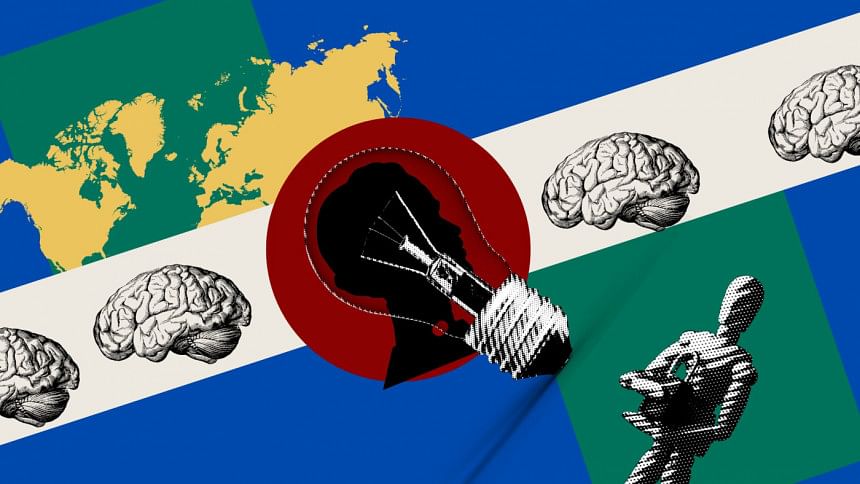How can Bangladesh realise its potential in innovation?

Innovation elevates productivity by introducing novel concepts, methods, and technological advancements that contribute to efficacy. This results in higher production from the same or fewer inputs, which is essential for economic growth. The World Intellectual Property Organization (WIPO) publishes the Global Innovation Index (GII), which ranks countries based on their innovation capabilities and outcomes, considering institutions, human resources and creative outputs. It has seven pillars that offer a comprehensive framework for evaluating global innovation performance, and two sub-indices: innovation input and innovation output.
In the GII 2024, Bangladesh's score reflects a mixed narrative—steady although constrained progress in certain innovation sectors, and systemic challenges in others. In addition, out of the 133 economies, the country stands at 106. It is also ranked 22nd out of 38 lower-middle-income economies. As a result, there is a pressing need to bridge the gap between its desire for economic expansion and the generation of innovative ideas. In this context, it is essential to comprehend the state of innovation in Bangladeshi firms and industries to determine how to get over these challenges and propel advancement.
As mentioned earlier, the GII assesses countries using a range of indicators that fall into two primary groups: innovation outputs and inputs. There is disparity between the innovative input and output which reveals a crucial component of Bangladesh's innovation ecosystem: although the country can produce innovative ideas, it finds it difficult to establish an atmosphere that encourages long-term innovation.
In addition, the country is ranked considerably low by the GII in categories like business sophistication and human capital and research. These areas are directly related to the aptitude of businesses and sectors to conduct research and development (R&D), integrate cutting-edge technology, and create environments that are conducive to innovation. Additionally, limited participation in global value chains, the lack of R&D partnerships with universities, and an absence of knowledge network integration are the primary hurdles at the firm level. Expenditure on research, education, and skills development is still sparce in Bangladesh.
While discussing innovation in contemporary sectors, access to digital infrastructure is essential, but instead, Bangladesh performs poorly in terms of fixed broadband and 5G access. Digital transformation requires better connectivity, especially as Bangladesh aims to boost its low-level, stagnant high-tech exports. To integrate data analytics, increase operational effectiveness, and link with global value chains, firms require a strong digital infrastructure. Accelerated investment in broadband infrastructure is necessary to ensure that businesses and industries outside of urban areas are not left behind. However, furthering this involvement at the corporate level is now a challenge, particularly in sectors like manufacturing, agribusiness, and textiles.
A potential solution for tackling the disparity involves expanding funding for advanced industries such as automation, artificial intelligence, and sophisticated procedures for manufacturing. For instance, firms in the RMG industry may leverage automation technology and more advanced digital supply chains to reduce inefficiencies and increase their competitiveness. In a similar vein, agribusiness firms may employ precision agricultural technologies to boost crop yields and resilience, potentially promoting economic growth and innovation.
Bangladesh requires immediate action to improve knowledge absorption, innovate connections, and stimulate the growth of knowledge-intensive jobs. Constraints without immediate remedies may prevent firms from engaging even in activities that have been regarded as beneficial to innovation, such as R&D collaborations with foreign or academic partners. Creativity in innovation clusters, coupled with collaboration among firms, universities and governments, are prerequisites to develop sophisticated skills. To optimise knowledge-sharing, these clusters should concentrate on sectors where Bangladesh excels, such as digital finance, clean energy, and textiles.
The expansion of Bangladesh's venture capital market is necessary to allow startups and small and medium enterprises (SMEs) to undertake risks, invest in new technology, and develop. This might create a source of funding for high-growth companies by offering incentives for private equity investment in emerging industries.
Bangladesh, which ranks 128th globally in human capital and research, is also experiencing a significant human capital crisis. Limited funding for education, particularly in STEM disciplines, and a shortage of skilled labour slow down industry innovation. Better education and vocational training are essential to produce a workforce capable of working in high-value industries, research, and entrepreneurship.
Moreover, the problem of missing or outdated data, especially in the high-tech, education, and research and development sectors, is a key revelation from the GII 2024 report. Nine of the indicators in Bangladesh have out-of-date data, while 13 indicators have missing data. This dearth of reliable data makes it more difficult to accurately evaluate Bangladesh's capacity for innovation as well as for businesses and governments to identify those areas that need adjustment. A more robust innovation ecosystem can be fostered by making well-informed policy decisions, which will require strengthening the data infrastructure.
In addition, Bangladesh's institutional quality (for which the country is ranked 108th) emphasises the necessity of changing regulatory frameworks to foster an atmosphere that is more conducive to business. Businesses frequently encounter administrative roadblocks and a lack of defined, uniform policies that foster creativity. Innovation potential in businesses could be greatly increased by streamlining the patenting and intellectual property protection processes, cutting red tape, and improving governance.
The GII 2024 provides a road map for Bangladesh's transition from small-scale innovation enhancements to becoming a regional innovation leader. Firms and industries in the country need to work more to encourage innovation, even though they are efficient at transforming innovation inputs into outputs. This will require higher R&D expenditures, more sophisticated business operations, and a workforce skilled to use new technologies. By utilising sectoral strengths and addressing structural shortcomings, Bangladesh can realise its full innovation potential. Ultimately, this would improve the country's long-term economic growth and competitiveness globally.
Afia Mubasshira Tiasha is senior research associate at the South Asian Network on Economic Modeling (SANEM). She can be reached at [email protected].
Views expressed in this article are the author's own.
Follow The Daily Star Opinion on Facebook for the latest opinions, commentaries and analyses by experts and professionals. To contribute your article or letter to The Daily Star Opinion, see our guidelines for submission.

 For all latest news, follow The Daily Star's Google News channel.
For all latest news, follow The Daily Star's Google News channel. 










Comments